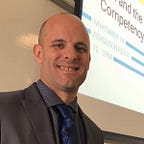Standards Based Grading and Creativity
If we measure something, do we kill it too?
Years ago I remember listening with rapt attention and fervor to Ken Robinsons Ted Talk “Do Schools Kill Creativity?”. It is still the most popular Ted Talk of all time.
I didn’t see mathematics as a creative pursuit until college and discovering that idea super-charged me! Solving the same problem “four different ways” or, “with algebra, geometry or Trigonometry” for example was something we did in a course for secondary teaching emphasis math majors called literally Problem Solving and it was amazing! During college as a math major, I began to see each problem was a knot to unravel — a puzzle to pick at! That mindset was unique and empowering! I know in HS if I didn’t understand how to solve something the first try or right away I’d just give up. Later, as a math teacher I strove to help my students see math as a creative pursuit instead of something to memorize.
A couple of years ago I read Weapons of Math Destruction and it essentially showed how anything that is measured can be gamed — from drivers tests to life insurance. As I’ve gone forward in my career and life, there is a constant dichotomy between wanting to see what students know, and also knowing that much like Schrodinger's’ Cat, ‘seeing’ means we’ve also somehow changed something.
I’m a huge believer in standards based instruction — the idea that we can and should be able to see where students gaps in understanding is at a more granular level. What’s most important is when they transfer between schools and even within their own school, teachers can see at a glance what concepts they’re struggling with, allowing for more personalized instruction. And there are a huge number of reasons why A/B/C etc are a really bad way to know what a student knows, including but not limited to the ability for a student to do really well and even skip some areas of knowledge, irresponsible use of extra credit in some courses, and differences in examination difficulty between teachers/schools/districts.
No-stakes formative assessment is the key to both engaging students and continuing to move forward and create conditions for creativity. Flipgrid videos, creating not just regurgitating. Distance learning now is not the time to try these things — but how about the fall?
Creative classrooms start with trust, discipline and the belief that all students can learn.
